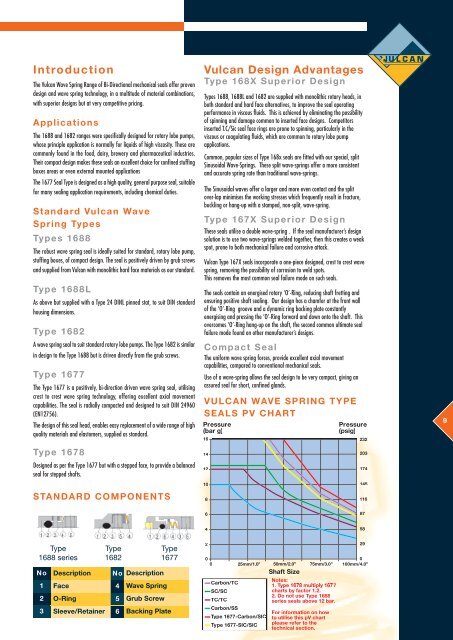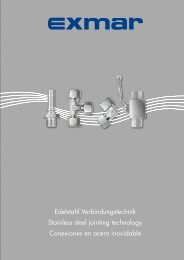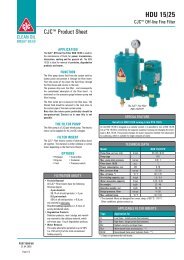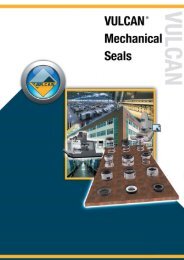Create successful ePaper yourself
Turn your PDF publications into a flip-book with our unique Google optimized e-Paper software.
Introduction<br />
The <strong>Vulcan</strong> <strong>Wave</strong> <strong>Spring</strong> Range of Bi-Directional mechanical seals offer proven<br />
design and wave spring technology, in a multitude of material combinations,<br />
with superior designs but at very competitive pricing.<br />
Applications<br />
The 1688 and 1682 ranges were specifically designed for rotary lobe pumps,<br />
whose principle application is normally for liquids of high viscosity. These are<br />
commonly found in the food, dairy, brewery and pharmaceutical industries.<br />
Their compact design makes these seals an excellent choice for confined stuffing<br />
boxes areas or even external mounted applications<br />
The 1677 Seal <strong>Type</strong> is designed as a high quality, general purpose seal, suitable<br />
for many sealing application requirements, including chemical duties.<br />
Standard <strong>Vulcan</strong> <strong>Wave</strong><br />
<strong>Spring</strong> <strong>Type</strong>s<br />
<strong>Type</strong>s 1688<br />
The robust wave spring seal is ideally suited for standard, rotary lobe pump,<br />
stuffing boxes, of compact design. The seal is positively driven by grub screws<br />
and supplied from <strong>Vulcan</strong> with monolithic hard face materials as our standard.<br />
<strong>Type</strong> 1688L<br />
As above but supplied with a <strong>Type</strong> 24 DINL pinned stat, to suit DIN standard<br />
housing dimensions.<br />
<strong>Type</strong> 1682<br />
A wave spring seal to suit standard rotary lobe pumps. The <strong>Type</strong> 1682 is similar<br />
in design to the <strong>Type</strong> 1688 but is driven directly from the grub screws.<br />
<strong>Type</strong> 1677<br />
The <strong>Type</strong> 1677 is a positively, bi-direction driven wave spring seal, utilising<br />
crest to crest wave spring technology, offering excellent axial movement<br />
capabilities. The seal is radially compacted and designed to suit DIN 24960<br />
(EN12756).<br />
The design of this seal head, enables easy replacement of a wide range of high<br />
quality materials and elastomers, supplied as standard.<br />
<strong>Type</strong> 1678<br />
Designed as per the <strong>Type</strong> 1677 but with a stepped face, to provide a balanced<br />
seal for stepped shafts.<br />
STANDARD COMPONENTS<br />
<strong>Vulcan</strong> Design Advantages<br />
<strong>Type</strong> 168X Superior Design<br />
<strong>Type</strong>s 1688, 1688L and 1682 are supplied with monolithic rotary heads, in<br />
both standard and hard face alternatives, to improve the seal operating<br />
performance in viscous fluids. This is achieved by eliminating the possibility<br />
of spinning and damage common to inserted face designs. Competitors<br />
inserted T.C/Sic seal face rings are prone to spinning, particularly in the<br />
viscous or coagulating fluids, which are common to rotary lobe pump<br />
applications.<br />
Common, popular sizes of <strong>Type</strong> 168x seals are fitted with our special, split<br />
Sinusoidal <strong>Wave</strong>-<strong>Spring</strong>s. These split wave-springs offer a more consistent<br />
and accurate spring rate than traditional wave-springs.<br />
The Sinusoidal waves offer a larger and more even contact and the split<br />
over-lap minimises the working stresses which frequently result in fracture,<br />
buckling or hang-up with a stamped, non-split, wave-spring.<br />
<strong>Type</strong> 167X Superior Design<br />
These seals utilise a double wave-spring . If the seal manufacturer’s design<br />
solution is to use two wave-springs welded together, then this creates a weak<br />
spot, prone to both mechanical failure and corrosive attack.<br />
<strong>Vulcan</strong> <strong>Type</strong> 167X seals incorporate a one-piece designed, crest to crest wave<br />
spring, removing the possibility of corrosion to weld spots.<br />
This removes the most common seal failure mode on such seals.<br />
The seals contain an energised rotary ‘O’-Ring, reducing shaft fretting and<br />
ensuring positive shaft sealing. Our design has a chamfer at the front wall<br />
of the ‘O’-Ring groove and a dynamic ring backing plate constantly<br />
energising and pressing the ‘O’-Ring forward and down onto the shaft. This<br />
overcomes ‘O’-Ring hang-up on the shaft, the second common ultimate seal<br />
failure mode found on other manufacturer’s designs.<br />
Compact Seal<br />
The uniform wave spring forces, provide excellent axial movement<br />
capabilities, compared to conventional mechanical seals.<br />
Use of a wave-spring allows the seal design to be very compact, giving an<br />
assured seal for short, confined glands.<br />
VULCAN WAVE SPRING TYPE<br />
SEALS PV CHART<br />
Pressure<br />
(bar g)<br />
16<br />
14<br />
12<br />
10<br />
8<br />
Pressure<br />
(psig)<br />
232<br />
203<br />
174<br />
145<br />
116<br />
9<br />
6<br />
87<br />
4<br />
58<br />
<strong>Type</strong><br />
1688 series<br />
No<br />
1<br />
2<br />
3<br />
Description<br />
Face<br />
O-Ring<br />
Sleeve/Retainer<br />
<strong>Type</strong><br />
1682<br />
<strong>Type</strong><br />
1677<br />
No Description<br />
4 <strong>Wave</strong> <strong>Spring</strong><br />
5 Grub Screw<br />
6 Backing Plate<br />
2<br />
0<br />
0<br />
0 25mm/1.0” 50mm/2.0” 75mm/3.0” 100mm/4.0”<br />
Carbon/TC<br />
SC/SC<br />
TC/TC<br />
Carbon/SS<br />
<strong>Type</strong> 1677-Carbon/SIC<br />
<strong>Type</strong> 1677-SIC/SIC<br />
Shaft Size<br />
Notes:<br />
1. Ty 7<br />
<strong>Type</strong> 1688<br />
series seals above 12 bar.<br />
For information on how<br />
to utilise this pV chart<br />
please refer to the<br />
technical section.<br />
29








